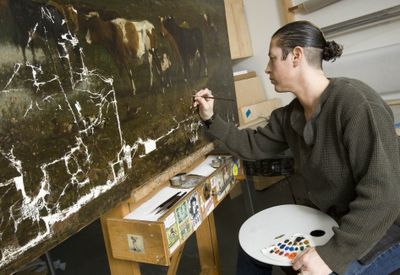More U.S. businesses using microloans

NEW YORK – When Amy Sokoloff and John Powell were trying to start their art restoration business in New York City, they needed some working capital. But banks weren’t willing to take a chance on them.
“We didn’t own anything – no houses, no cars, we had no collateral,” Sokoloff said. Powell added, “No one wanted to talk to us. They were not interested, and they were not nice about it.”
Sokoloff and Powell ended up on the doorstep of ACCION USA, a not-for-profit group patterned after the Third World microfinance institutions best known for providing money to Moroccan farmers for breeding chickens or to Bangladeshi women for weaving supplies.
The $15,000 loan they got in 2005 – which they paid back in two years – got them the sunlit studio where their Chelsea Restoration Associates brings aged, damaged oil paintings back to life. Last fall, after the U.S. downturn began to cut into their business, they went back to ACCION USA for a $25,000 loan, “a tremendous help for cash flow” with an affordable 10.9 percent interest rate, Sokoloff said.
Sokoloff and Powell are among thousands of Americans using microcredit, a financing system originated in the Third World, to help open small businesses or get through rough spots. While the dollar amounts are much bigger in the U.S. than the tiny loans in developing countries – some for less than $10 – the principle is the same: a financial stake that lets people in need better their lives.
Now, with the recession deepening, U.S.-based microlenders say they are seeing an increase in inquiries from would-be borrowers, including startup entrepreneurs seen as too risky by banks and other traditional lenders.
And the still-small U.S. microcredit sector hopes for a boost from the new administration of President Barack Obama.
Obama’s secretary of state, Hillary Clinton, is a big supporter of microfinance, praising it during her confirmation hearing for its ability to “raise standards of living and transform local economies” overseas. Obama also has a personal link to the industry because his late mother, Ann Dunham, was involved in microfinance in Indonesia.
These connections gave raised hopes among microloan advocates that some money from the administration’s $789 billion economic rescue package will filter into their programs. U.S. microlenders already get support from the Small Business Administration and a special Treasury community development fund.
“We’re hoping for more funding” from the government, said Wendy K. Baumann, vice chairman of the Association for Enterprise Opportunity, an advocacy group for microfinance based in Arlington, Va.
Microloans have been made in developing countries for more than 30 years. Bangladeshi economist Mohammed Yunis made the first one of about $27 from his own pocket to 42 women who needed to buy bamboo to make furniture. He later formed the Grameen Bank, which is now one of the world’s largest microlenders and shared the 2006 Nobel Peace Prize with the founder.
In 2007, microloans went to some 154 million people worldwide, according to the Microcredit Summit Campaign. Estimates vary, but there are believed to be some $25 billion to $30 billion in small business loans outstanding globally.
In the United States, by contrast, an estimated $100 million in microloans were provided to 13,000 clients by some 250 microlenders in 2007, according to Elaine L. Edgcomb, director of an Aspen Institute project on the small loan movement. The average for these loans is about $8,000 in the U.S., she said.
Microlending groups estimated that defaults were a manageable 6 percent to 8 percent before the economy fell into recession but have grown since.
Gina Harman, president of New York-based ACCION USA, the largest of the microlenders in the United States, said that nonprofit groups like hers were “very hands on” with borrowers and admitted “we’re working harder these days to keep people current.”
Harman said that in addition to the unemployed and the underemployed, a big market for microloans in the United States is the immigrant community.
“Self-employment rises in importance for recent immigrants because their alternatives for jobs are limited,” Harman said. Many don’t know English and lack business connections, but come from cultures with strong entrepreneurial skills, she added.
Baumann of the Association for Enterprise Opportunity believes more money will become available for microloans.
“Credit is tightening, and more people are coming to us,” she said, adding that this should prompt banks and other big financial institutions “to wake up and figure out how we can partner with them” to support small businesses.